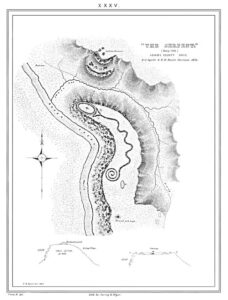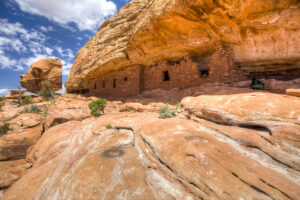Ask someone what they know about archaeology and they’re likely to spout off a few tropey figures: Indiana Jones, Lara Croft, or Brendan Fraser from The Mummy movies. Cue scenes of harrowing adventures, mysterious artifacts, and undiscovered Mayan temples or Egyptian tombs. Popular media has spun a provocative yarn about archaeology, one full of adventure, exoticism, and treasure.
Although these portrayals of archaeology are wildly inaccurate in many ways, there are grains of truth sprinkled throughout their storylines. Just think of one of Indy’s most famous lines: “It belongs in a museum!” For many years, this quote echoed a sentiment deeply rooted in the minds of many real-world archaeologists — that they were duty-bound to “rescue” artifacts from their original contexts and tuck them away in a museum storeroom, never to be returned to their place of origin.
The ethical legacy of this conviction has become a major topic of discussion among archaeologists and the broader public in recent years. Many European museums have been condemned for maintaining ownership of African, Greek, and Middle Eastern relics, an issue that has gained global attention.
Now the United States is facing increased backlash for committing similar offenses — on its own soil. Stretching back over a century, American archaeology has a deep history of “rescuing” Native culture. Across the country, countless indigenous burial goods, sacred objects, and human remains have been unearthed in the name of science. However, renewed advocacy by and for American Indian communities has begun to right this wrong. Increased awareness of these so-called stolen artifacts has inspired significant change, not only among archaeologists and museum curators, but also within the highest levels of the federal government.
The Historical Legacy of American Archaeology

In the late nineteenth and early twentieth centuries, professional and avocational archaeologists alike crisscrossed the United States, digging up American Indian graves and sacred sites on private land. They collected ancient pottery vessels, ritual art objects, and even the bones of people laid to rest centuries ago. These archaeologists, who often entrusted their finds to respected institutions (Ivy League colleges, the Smithsonian, or any number of land-grant universities), viewed this material as scientific data, conflating Native culture with natural history collections containing fossils, rocks, or snakes in jars of formaldehyde. Nobody stopped to consider that American Indians — who were still very much alive despite being labeled a “vanishing race” — might object to the systematic plundering of their ancestral homelands.
While their work was not up to modern ethical or scientific standards, early archaeologists deserve some grace — it was a different era, after all. What should perhaps be more troubling is that, rather than being returned to Native communities, many of these objects are still owned by the same elite institutions that acquired them more than one hundred years ago. This is especially surprising given that the United States enacted a law in 1990 to address this exact problem. The Native American Graves Protection and Repatriation Act, or NAGPRA for short, requires that ownership of all indigenous human remains, funerary items, and sacred objects held by institutions receiving federal funding be restored, or repatriated, to rightful lineal descendants. In other words, a large percentage of the objects brazenly unearthed around the turn of the century must — by law — be given back to contemporary tribal nations.
While NAGPRA has been successful in some senses (since 1990, federal agencies in particular have returned 91.5% of culturally identifiable human remains to present-day tribes), it hasn’t worked that well — especially given that it was passed more than 30 years ago. Many museums have been criticized for dragging their feet on completing NAGPRA inventories or initiating repatriation efforts. Other institutions have been accused of subverting NAGPRA by implying that large collections of sacred artifacts and human remains have no known cultural affiliation with contemporary tribes.

For instance, recently leaked documents suggest that Harvard still holds the excavated bones of nearly 7,000 Native people (although repatriation is underway). And this past year, several tribes with ancestral ties to the Southeast confronted the University of Alabama about its perceived unwillingness to affiliate or repatriate sacred objects and remains associated with a major archaeological site near Tuscaloosa. These and other instances of NAGPRA noncompliance imply that many institutions continue to view archaeological materials as scientific data — not as sensitive cultural objects.
The Way Forward
In response to these issues, American Indians have been fighting to rebrand their material culture as an important reflection of their humanity, history, and spirituality. These efforts have now paid off. After three decades of lackluster enforcement, it was recently announced that NAGPRA is in the process of getting an update. In the summer of 2021, the Department of the Interior began consultations with 71 tribal nations, resulting in a draft proposal of revised regulations that takes into account more than 700 specific comments from American Indian communities. Among other points, tribes called for more timely repatriation processes, increased transparency from museums regarding their collections of sensitive artifacts and human remains, and — most importantly — less red tape surrounding tribal claims of cultural affiliation with archaeological sites and materials. To enforce institutions’ future compliance with NAGPRA, the National Park Service hired a full-time civil penalties investigator in January 2022.

For many, this is a major advancement toward justice for American Indians, a culmination of years-long efforts by indigenous communities, museum professionals, and a younger generation of archaeologists to correct damages perpetrated in the past. The recent spotlight put on NAGPRA has already led to many small, but important, successes. For example, reburials of repatriated human remains have recently been completed in Alaska, Florida, and Indiana. Harvard just returned Chief Standing Bear’s pipe tomahawk to the Ponca Tribe. And in June, President Biden restored the managerial role of five southwestern tribes in preserving Bears Ears National Monument, a right revoked by Donald Trump in 2017. These tribes hope to secure the repatriation of objects that have been removed from the site.
Despite these achievements, there are still many hurdles to be cleared, including the protection of other important Native landmarks, the expansion of tribal sovereignty, the advancement of indigenous archaeology, and the federal recognition of more than 200 tribes who do not yet stand to reap the benefits of a revised NAGPRA. But, as the wheels of justice continue to grind, many American archaeologists have recognized the ethical imperative of reorienting the goals of the discipline to amplify the voices of marginalized groups.
The daring adventurer, whip in hand, reflects archaeology’s checkered past. A new image has yet to emerge, but this recent glimmer of hope for a more righteous future promises major changes — for the good.
Featured photo: Rainmaking among the Mandan, George Catlin, 1830s. Smithsonian American Art Museum
Peer editor: Aditi Kothari